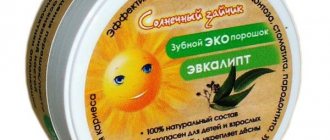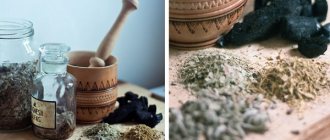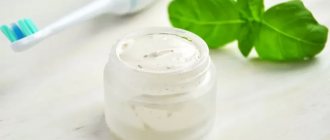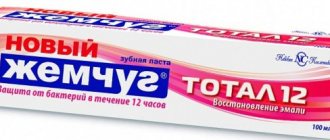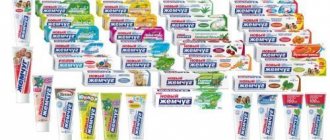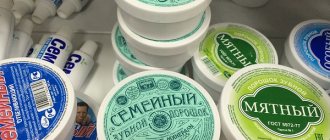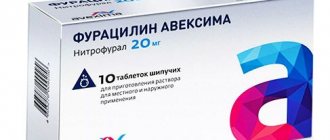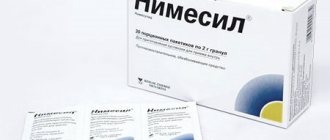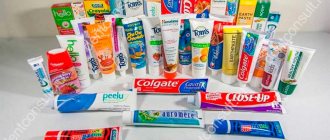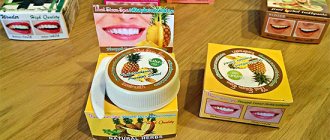Purpose
It should be noted that at that time the purpose of tooth powder was not to prevent caries or treat periodontitis. At that time they did not even know such words, did not understand the reasons for their occurrence, and therefore could not yet contain these diseases with hygienic means. The main and only goal was to cleanse the teeth of plaque and tartar. Please note: in the first half of the 20th century, dentists had not yet performed such a now widespread procedure as professional oral hygiene. Neither ultrasonic nor air-abrasive (Air-Flow) treatment had yet been invented. The only way to remove conspicuous plaque is to clean it yourself.
Pros and cons of using
Tooth powder copes well with the formation of plaque and prevents it from hardening and turning into tartar. Favors the development of good microflora.
But at the same time, frequent use can serve to destroy the enamel and, consequently, aggravate unpleasant sensations: sensitivity to cold and hot, pain, as well as the development of caries and inflammatory processes.
pros
The advantages of tooth powder also include:
- natural ingredients;
- high-quality plaque removal;
- softening of tartar;
- whitening properties;
- polishing;
- elimination of unpleasant odor;
- prevention and treatment of gingivitis and periodontitis;
- providing minerals and vitamins to oral tissues;
- ensuring normal ph;
- pathogen control;
- economical consumption;
- long shelf life;
- budget price.
There is information that the powder can be harmful if used continuously. Indeed, if you use only powder with coarse abrasives several times a day for several months, there is a possibility of damage to the enamel. Therefore, it is enough to use the powder 1-2 times a day and alternate it with pastes.
If the powder in the composition does not contain coarse particles, then it can be used without fear.
Minuses
Are there any disadvantages to tooth powder? Yes, of course there is, like any medicine and even a neutral product.
Flaws:
- if sensitivity is increased, the powder can enhance it, so it is important to choose the right composition;
- abrasive particles can damage thin enamel and contribute to sensitivity;
- regular packaging is not convenient; when used, the powder may get wet, and a loose lid will not preserve the powder if the jar falls;
- treatment for a number of oral diseases is impossible without additional components or the participation of a dentist;
- When treating teeth with powder, it is important to follow the direction of movement, clean correctly and not violate the technology.
If industrial formulations cannot lead to the expected result, you can create the powder yourself or order it from those who manufacture it using an individual recipe and technology.
Starting line-up
Therefore, a good century-old tooth powder is one that has excellent abrasive properties. Hence they added to it: pumice, sand, ground bones, eggshells, mollusk shells, broken bricks and God knows what else. It must be said that toothpastes of those times were in no way behind powders in terms of abrasiveness. Moreover, to help a good cause, individual inventors added acids and alkalis of varying degrees of aggressiveness to them. Well, of course - after all, tartar softened by acid is easier to remove (alkali has not proven its worth in this regard). In general, the evolution of hygiene products has moved towards clearly expressed aggressiveness.
Powder or paste - which to choose?
To answer the question of which is better to prefer - powder or paste, it is first worth comparing these two products. Below are the key points regarding both products:
- inconvenient packaging of the powder increases the risk of contamination, so you will have to be especially careful to ensure that dust, dirt, moisture does not get into the box,
- the paste is more convenient to use, because it has a dense, contamination-proof packaging in the form of a tube with a dispenser,
- the powder does not foam, and for some this characteristic may be of serious importance,
- the dry product does not have an antifungal effect, but in fairness it is worth noting that not all pastes have a similar effect1,
- The dry composition, due to its abrasive effect, provides a more thorough cleansing of the enamel - removes plaque, dental deposits, and whitens. Additionally polishes the enamel and freshens breath,
- the paste is suitable for daily use, while the powder can be used no more than 2-3 times a week. In this regard, it is not entirely advisable to compare the two products, since the dry composition is effective as an additional hygiene product.
And one more nuance: special components are added to modern pastes that allow it to foam well. However, these substances pose a certain danger to the body. We are talking about sodium lauryl sulfate and triclosan - the latter is added as an additional antibacterial component, however, along with pathogenic microflora, it also removes beneficial bacteria.
Harm
But in 1907, an outstanding article was published in The Dental Cosmos: Miller WD. Experiments and observations of the wasting of tooth tissue variously designated as erosion, abrasion, chemical abrasion, denudation, etc. It had about the same impact on dentists as Albert Einstein’s “On the Electrodynamics of Moving Bodies,” published two years earlier, had on physicists. Equipped with terrifying illustrations, it clearly demonstrated the monstrous abrasion of teeth (in vitro) with pastes and powders. Here's one example:
Quality improvement
Of course, not all dentists read this study. Consumers of the powder certainly had no idea about it. Therefore, it took decades before highly abrasive components began to be abandoned. Such useful indicators as RDA (relative dentin abrasivity) and REA (relative enamel abrasivity) were introduced. The lower they are, the less the teeth wear out. Today, manufacturers who respect their customers indicate digital RDA values on each tube. Less than 70 – low abrasiveness, 71-100 – moderate, 101-150 – high, 151-200 – very high. Here is the RDA table for some modern pastes:
| Toothpaste name | RDA | Toothpaste name | RDA |
| Toothbrush with plain water | 4 | Colgate Sensitive Max Strength | 83 |
| Regular baking soda | 7 | Aquafresh Sensitive | 91 |
| Weleda Salt Toothpaste | 15 | Sensodyne Cool Gel | 92 |
| Elmex Sensitive Plus | 30 | Rembrandt Plus | 94 |
| Sensodyne ProNamel | 34 | Sensodyne Fresh Impact | 94 |
| Arm & Hammer Dental Care | 35 | Sensodyne Original | 100 |
| Weleda Calendula Toothpaste | 45 | Sensodyne Extra Whitening | 104 |
| Weleda Ratanhia Toothpaste | 45 | Sensodyne Full Protection Whitening | 107 |
| Arm & Hammer Dental Care Sensitive | 48 | Aquafresh Whitening | 113 |
| Tom's of Maine Children Toothpaste | 57 | Lacalut White | 120 |
| Colgate Sensitive Enamel Protect | 63 | Colgate Total Whitening | 142 |
| ClinPro | 65 | Colgate Total Advanced Fresh | 160 |
| Colgate Regular | 68 | Colgate Tartar Control | 165 |
| Colgate Total | 70 | Colgate 2-in-1 Tartar Control/Whitening | 200 |
| Colgate Fresh Mint | 70 | President White Plus | 200 |
Modern composition
So, coarse abrasives were disqualified from the contents of tooth powder. But what is there now? Soda, as can be seen from the table, has minimal harmful qualities. It is harmless, but its effectiveness is low. It weakly cleans plaque and does not “take away” tartar at all. Its hardness on the Mohs scale is 2.5. That's why the main ingredient in today's tooth powders is chalk (calcium carbonate). Its hardness on the Mohs scale is 3. It cleans teeth relatively gently and is more effective than soda. The rest is fragrances, flavor enhancers, dyes, etc.
Popular means
As an example, here are several varieties of this product from well-known manufacturers.
Gum Gold / Gum Gold
This is an Ayurvedic remedy that contains many beneficial herbs and components.
Among them:
- mint,
- him,
- ginger,
- galanga,
- Red stone,
- mountain salt.
Regular use allows you to strengthen the gums and enamel, reduce bleeding of soft tissues, relieve inflammation and increase microcirculation of blood in the periodontal tissues, whiten and polish the enamel without causing harm.
Completely natural composition with no artificial additives.
The cost of a 60 g package is about 200–230 rubles.
For those who should use bamboo toothbrushes with charcoal coating, read our new review.
In the next publication we will talk about the features of oral sanitation during pregnancy.
At the link https://www.vash-dentist.ru/krasota-i-uxod/otbelivanie/kak-provoditsya-zubov-aktivirovannyim-uglem.html you can read the opinions of dentists on the use of activated carbon for whitening and leave your review.
Lion Tobacco
Created specifically for smokers to effectively protect against a specific unpleasant odor and heavy plaque. The whitening effect can be achieved within a few days.
Sold in packs of 160 grams, the cost is on average 350–370 rubles .
Sunny bunny
The main composition contains 14 herbs : mint, dandelion, sage, thyme, chamomile, oak, St. John's wort, calamus, nettle, alfalfa, birch, ginger, agrimony, coltsfoot.
Safe for children, helps fight inflammation in the gums, reduce bleeding and gently whiten.
The package contains 50 grams, its cost is about 330 - 340 rubles.
Mint
The base – calcium carbonate – is supplemented with menthol and natural mint oil .
Does not contain additional fragrances or harmful components.
The cost of packaging (140 g) is about 25–40 rubles.
The final victory of toothpaste
Back in 1914, there were attempts to introduce fluoride into toothpaste. But only after large-scale research in the early 1950s, which proved the effectiveness of fluoride toothpastes, did active commercial production begin. The pioneer was Procter & Gamble with Crest toothpaste. Then the rest of the manufacturers picked up the baton. In addition to fluorides (to prevent caries), antiseptics and anti-inflammatory components (to fight gingivitis), and desensitizing substances (to reduce dental hyperesthesia) began to be added to the paste.
Where in the world is it used?
In developed countries, tooth powder is not produced. The last known global leader in the hygiene industry, Arm & Hammer, ceased sales in 2000. In Russia, tooth powder is used by 23% of the population. A recent study was conducted in India in 2022: it was found that 31% of rural residents and 15% of urban respondents use tooth powder. A strong relationship has been found between the use of tooth powder and abrasion of tooth tissue, bleeding and gum recession. This is the “beauty” you get after consuming Indian tooth powder:
How to brush your teeth correctly
Please note that despite the fact that most of the Indian tooth powder fan's own enamel has been erased, the black plaque has not been cleaned out everywhere. And this is on the front surface - you can imagine how much worse the situation is on the internal surfaces. This happens because brushing your teeth requires, first of all, not strength, but intelligence. Instead of violent movements, moderate but frequent movements are needed. Not horizontal, but vertical, sweeping. From the gum to the tooth: from bottom to top - on the lower jaw, from top to bottom - on the upper jaw. And, naturally, you need to brush your teeth not only on major holidays, but every day. Then the soft plaque will not yet have time to calcify and stick firmly to the enamel.
What are the disadvantages of the product?
Despite the undeniable benefits of the product, it also has some disadvantages, the main one of which is high abrasiveness. That is why it is not recommended to use it too often - you can damage the enamel and provoke its increased sensitivity.
Another disadvantage is the inconvenience of use. The powder is sold in small round boxes with an airtight lid. When applied to a brush, it often crumbles, and its direct contact with the bristles leads to rapid deterioration of the product. That is why you should first pour a little of the composition into a separate container.
Features of use
For tooth powder, the instructions for use are a little more complicated than for toothpaste. The toothbrush should be moistened with water and the wet bristles should be dipped into a jar of powder. It is advisable to immediately collect a portion for the entire one-time cleaning. After all, when re-sampling, microorganisms will get into the powder. Bacteria, by the way, will still end up in the jar (unless you use disposable brushes), because they remain on the fibers from the previous cleaning. But in the 12 hours that have passed since the last hygiene procedure, most of the microbes have already died and do not pose any danger to the owner. The same cannot be said about other members of the family. Therefore, everyone should have a personal jar of tooth powder - otherwise there is a high risk of infecting close relatives. This is another inconvenience compared to toothpaste - the whole family can use a common tube.
Reviews
Why then are there such a huge number of positive reviews about tooth powder on the Internet and among friends? It’s not surprising - there are also a lot of words of praise about homeopathy and osteopathy. Valerian, Actovegin, Linex and a hundred or two other ineffective drugs find no less devoted admirers. A person is such an amazing creature that, having convinced himself of the usefulness of a particular drug, he can actually achieve a positive effect, even if this drug is an absolute dummy. This is called the placebo effect. After persistent self-hypnosis, the transition to truly more effective therapeutic and prophylactic agents is often met with hostility. Plus, irreversible negative consequences do not occur immediately. They include, among other things, the absence of a positive impact (prevention of diseases), which few fans think about.
How to make tooth powder at home
There are dozens and even hundreds of recipes that are not difficult to find online for making your own tooth powder.
Luckily, instead of ash and eggshells, these mixtures are based on relatively easily obtained ingredients such as chalk, powdered sugar, baking soda, borax, charcoal, honey and peppermint oil, among other ingredients.
One of the universal recipes:
Base: White clay. To it are added: ground sea salt, ground dried tansy, mint, pine needle extract, 2-3 drops of tea tree essential oil. Each bulk ingredient is taken at a rate of 1:30, where one part of the substance is added to 30 parts of white clay.
Natural product
In addition to the low cost and supposedly better cleansing effect, many people are attracted to tooth powder by its environmental friendliness. Sodium lauryl sulfate, methylparaben, cocamidopropyl betaine and other horrors in toothpastes cause pronounced protest and rejection among many citizens. It’s difficult to argue with anything here - if you are a staunch opponent of “chemistry”, perhaps tooth powder is your choice. Only then be consistent - if your teeth suddenly hurt, do not treat them. After all, all modern fillings, crowns, dentures, and implants are also made of artificial materials. The natural behavior would be to remove the tooth, as our ancestors did (including those who used tooth powder a hundred years ago).
Different kinds
Oral hygiene is carried out in accordance with the age of the person and the condition of his oral cavity.
This is how they distinguish:
- Adult and children's powder formulations;
- Therapeutic and preventive;
- Whitening.
The children's product contains precipitated chalk of the finest fraction, additives are minimized and the vast majority are plant-based.
If after the cleansing procedure there are unpleasant sensations, pain, or discomfort, you should visit a doctor. Perhaps these are signs of incipient caries or periodontitis, which are easier to treat at the initial stage.
There are many types of dry cleaning compositions on sale, which differ in the following parameters:
- Aromatic and flavoring additives (cinnamon, ginger, nutmeg, mint).
- Additional natural ingredients (chalk, white clay, herbal extracts).
The choice of product depends on the age of the consumer, purpose of use and preference regarding aroma. Description of proven products that are in demand:
- Family . Does not contain toxic or carcinogenic compounds. Highly effective in removing soft plaque and formed dental deposits from the enamel surface.
- Whitening . A product with a whitening effect without dyes or fragrances.
- Mint . Thanks to the components of the powder, it has an antibacterial and anti-inflammatory effect, cleans and strengthens teeth well.
- Children's . The composition includes useful minerals, essential oils and extracts of medicinal plants that heal teeth and gums. Gently and effectively cleanses the enamel of baby and permanent teeth.
Reviews from doctors
Why then do dentists recommend tooth powder? Well, not all dentists, but only some. And these latter are a minority. Of this minority, one half has never read a single book on their specialty in their lives (yes, don’t doubt it – such copies exist). I read the second half, but these were reprints of Soviet textbooks from the 30s (and toothpaste was not produced in the USSR until 1950). And the third half, although familiar with modern concepts, understood little about them. If you ask such scholars the question: “What randomized controlled studies are you willing to refer to to confirm your recommendation?”, you may encounter the most unexpected response.
Conspiracy of toothpaste manufacturers
But there are also completely unique opinions from dentists. One well-known Moscow orthodontist (a competent doctor, a supporter of evidence-based medicine) posted a publication on her own website: “How dangerous is tooth powder?” With 31 links to sources of information - to give due weight to your own words. The article contains a lot of reliable information, but the conclusions are paradoxical. From the thesis about the higher abrasiveness of certain toothpastes compared to some tooth powders, the author concludes that the superiority of toothpaste over tooth powder is a myth. Formed by advertising from greedy paste manufacturers. No analysis or explanation of why evil advertisers chose for promotion a powder that was not well-known to everyone at that time, but a new, unpromoted product (and, therefore, requiring greater campaign costs) is naturally not presented. This same characteristic mistake is also popular among patients. But you only have to think a little to realize that it is much easier to advertise a cheap, low-cost, and even much more popular product to increase its selling price - and the conspiracy theory will naturally dissolve.
Recommendations for use
It is important to carry out personal hygiene using a powder product, following certain principles. Among them:
- alternation of funds;
- high-quality rinsing;
- proper brushing of teeth and tongue.
Detailed instructions for use
Packages of dental powders usually have mini instructions on how to use them. But there are also a number of rules and tips for cleaning itself, which the dentist tells:
- Apply a little powder to a damp brush (it is advisable to use a dispenser and do not dip the brush into the jar).
- Carry out the first stage of cleaning the surface of the teeth.
Make only vertical movements (they better clean hard-to-reach places and do not cause harm). Do not press on the brush, but make gentle movements. Record the procedure time – at least 3 minutes. Don't forget to clean your tongue and cheeks. - If necessary, repeat the cleaning step a second time or add a portion of the product (not recommended for hypersensitivity).
- Rinse your mouth and brush thoroughly to prevent bacteria from growing on it.
And in the next video we’ll learn more ways to help whiten your teeth:
Storage rules
The package of tooth powder should be stored tightly closed in a dark and cool place, away from direct sunlight. Favorable temperature conditions for long-term storage from 0 to +25 degrees.
Packaging usually has a shelf life of 12 months to 2 years, depending on the manufacturer and composition. The main thing is to monitor the humidity in the room and prevent water from getting inside the jar with the product.
When using, it is important to place the open jar on a stable surface away from water or close the lid immediately to avoid falling and splashing.
Frequency of use
Dentists recommend alternating regular toothpastes with whitening ones , and using a combination of powders, rinses and cleaning threads. The optimal frequency of using tooth powder is two days a week.
Lovers of coffee, strong tea and cigarettes can brush their teeth more often. Preventive treatment courses lasting a week can be carried out.
With regular use of the powder, the tone will lighten gradually. To achieve a quick whitening effect, you can make application masks on your teeth using cotton pads, applying a paste of powder to them.
Keep this mask in your mouth for 15 minutes. This method has a good strengthening effect.
